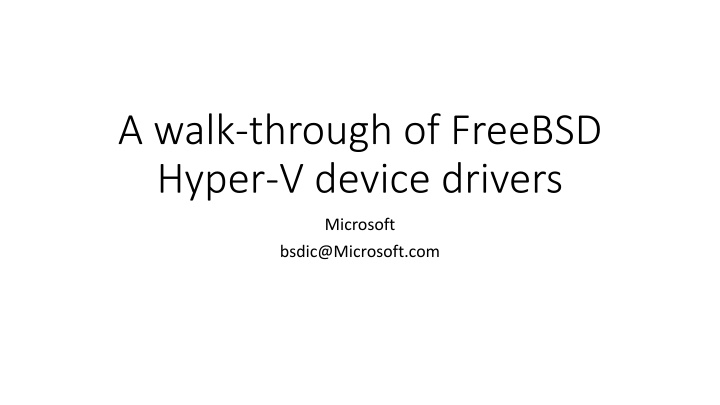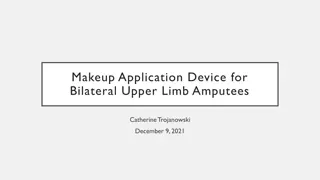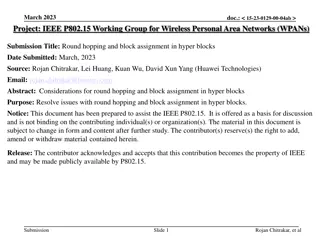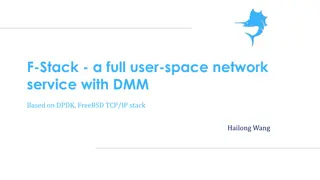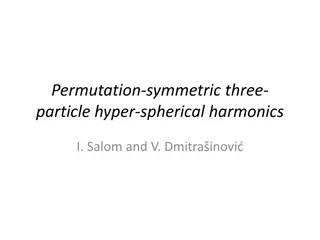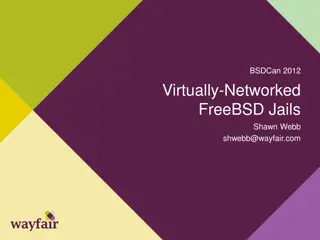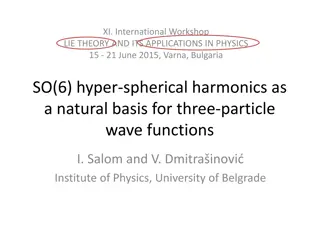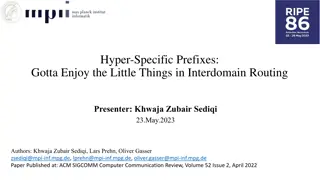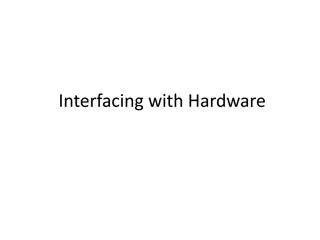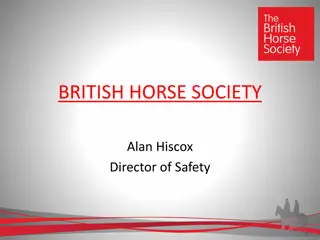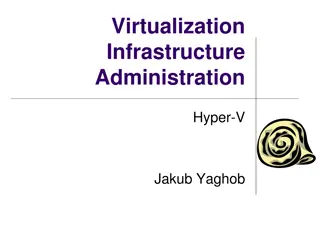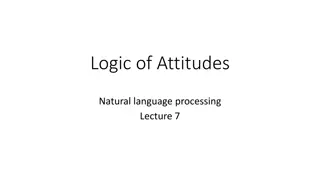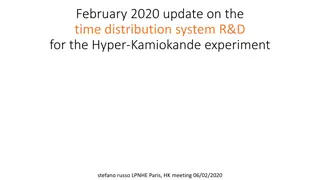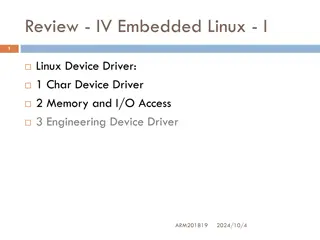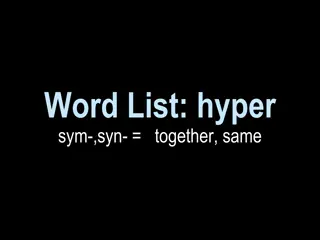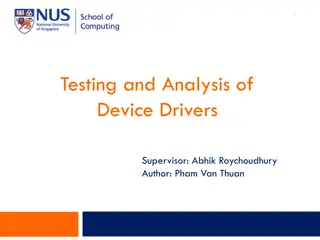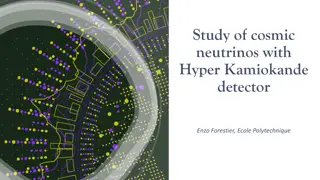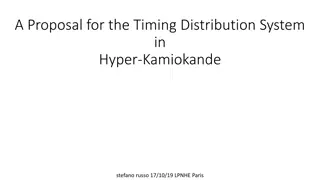Hyper-V Device Drivers in FreeBSD
Explore the integration of FreeBSD with Hyper-V, Microsoft's virtualization platform, including device driver directories, device tree layouts, and connection frameworks like vmbus in this informative walkthrough. Learn how to identify and attach child devices using FreeBSD's newbus framework for seamless operation in Hyper-V environments.
Download Presentation

Please find below an Image/Link to download the presentation.
The content on the website is provided AS IS for your information and personal use only. It may not be sold, licensed, or shared on other websites without obtaining consent from the author.If you encounter any issues during the download, it is possible that the publisher has removed the file from their server.
You are allowed to download the files provided on this website for personal or commercial use, subject to the condition that they are used lawfully. All files are the property of their respective owners.
The content on the website is provided AS IS for your information and personal use only. It may not be sold, licensed, or shared on other websites without obtaining consent from the author.
E N D
Presentation Transcript
A walk-through of FreeBSD Hyper-V device drivers Microsoft bsdic@Microsoft.com
Whats Hyper-V/Azure - Hyper-V is a hypervisor based virtualization platform developed by Microsoft. - Azure provides public cloud service and is primarily based on Hyper-V.
Typical Hyper-V device tree Hyper-V Generation 1 and Azure Hyper-V Generation 2
Hyper-V device driver directory layout vmbus/. The parent of all Hyper-V devices. It also contains code for early initialization, i.e. before any drivers are loaded. - storvsc/. Synthetic SCSI controller driver. - netvsc/. Synthetic network controller driver. - pcib/. PCI bridge driver for SR-IOV/pass-through. - input/. Synthetic keyboard driver. - utilities/. Drivers for KVP, VSS, time synchronization etc. - include/. Shared header files; exposed by the vmbus. -
Before any drivers are loaded - Confirm that the underlying hypervisor is Hyper-V. - Some hypervisor emulates Hyper-V s signature. - Register guest OS type through MSR. - This is one of the bits that you may want to customize. - Create Hypercall. - Hypercall: relatively heavy weight Hyper-V/guest communication mechanism. - Utilize SYSINIT; run before SI_SUB_DRIVERS/SI_ORDER_ANY. - Source code: dev/hyperv/vmbus/hyperv.c
Hyper-V vmbus and FreeBSDs newbus framework - device_identify device method and DRIVER_MODULE macro is convenient to attach child device: static device_method_t vmbus_methods[] = { DEVMETHOD(device_identify, vmbus_identify), DRIVER_MODULE(vmbus, pcib, vmbus_driver, vmbus_devclass, NULL, NULL); static void vmbus_identify(driver_t *, device_t parent) { device_add_child(parent, vmbus , -1); } Only two effective lines of code are needed to hook vmbus0 to pcib0. -
Hyper-V vmbus and FreeBSDs newbus framework - The parent device will have to be cooperative. Here is the one-liner, which is the last missing piece of the puzzle: dev/acpica/acpi_pcib_acpi.c: static int acpi_pcib_acpi_attach(device_t dev) { /* call device_identify of potential children. */ bus_generic_probe(dev); if (device_add_child(dev, "pci", -1) == NULL) { }
Hyper-V vmbus and FreeBSDs newbus framework - device_attach device method has some special requirement: - All available APs must be activated, since it needs to read/write per-cpu MSRs. - Properly functioning pause(9) is required. - In the end, the heavy lift of the vmbus_attach is deferred to config_intrhook: - vmbus_doattach.
Hyper-Vs soul: channel (a quick glance) Primary channel - Represent a synthetic device, e.g. synthetic network controller. - Possess GUID. - So that driver can match it against its GUID support list. Sub-channel - Only exists on device can do heavy I/O. - e.g. Synthetic network/SCSI controllers as of this write.
Hyper-V vmbus resource allocation - hyperv event taskqueues. - Per-cpu. - Run driver s data path and control path code, e.g. read/write channel. - Highly active under network/disk load. - hyperv msg taskqueues. - Per-cpu. - Only the taskqueue running on the cpu0 is actually required. - Mainly handle channel management messages. - Channel attach/detach/setup/teardown. - Mostly idle. - IDT entries. - Per-cpu. One IDT entry on each CPU. For both event and msg interrupts sent by Hyper-V. Real works are offloaded to hyperv msg and hyperv event taskqueues. - - -
Hyper-V vmbus resource allocation - vmbus dev taskqueue. - Only one. - Create device_t after the corresponding primary channel is created. - Run driver s device_probe/device_attach. - Delete device_t, before the primary channel is about to be destroyed. - Indirectly run driver s device_detach. - Thread-serialized driver s device_attach/device_detach. - vmbus subch taskqueue. - Only one. - Handle sub-channel detach notification. - Mainly to avoid sub-channel detach wait/notification deadlock, if only vmbus dev taskqueue existed.
Hyper-V device discovery Pandora s box is opened by: - Sending channel request message to Hyper-V through Hypercall. - This message has no reply.
Hyper-V device discovery - Hyper-V sends a set of channel offer messages to FreeBSD. - Each channel offer message here offers one primary channel. - Represents one synthetic device. - e.g. synthetic network controller. - Hyper-V sends channel offer done message to FreeBSD. - After the last channel offer message is dispatched to FreeBSD. - The arrival of channel offer done is notified from vmbus dev taskqueue. - This implies that all drivers device_attach has completed. - vmbus_doattach returns, so that system can move on to the next config_intrhook. - The attachment of the vmbus is considered done now.
Hyper-V device hot-plug - Hyper-V sends a channel offer message to FreeBSD for hot-plugged device. - Exact same format and meaning as the channel offer messages FreeBSD received during Hyper-V device discovery. - No channel offer done message follows.
Hyper-V device hot-remove - Hyper-V sends a channel rescind message to FreeBSD for device about to be hot-removed. - The channel rescind message here contains a primary channel.
Hyper-V vmbus summary - Parent of all Hyper-V devices. - Allocate system resources for channel operation. - Discover/Destroy Hyper-V devices. - Caller of Hyper-V device s device_attach/device_detach. - Source code: - dev/hyperv/vmbus/vmbus.c - dev/hyperv/vmbus/vmbus_chan.c
Hyper-Vs soul: channel (a close look)
Hyper-Vs soul: channel buffer ring - 2 buffer rings. - First 4KB of buffer ring contains consumer/producer indices and controlling flags. - RX bufring: read data from Hyper-V. - FreeBSD moves the consumer index. - Hyper-V moves the producer index. - Control channel interrupt generation. - TX bufring: send data to Hyper-V. - FreeBSD moves the producer index. - Hyper-V moves the consumer index. - Need to inform Hyper-V, if producer and consumer indices become different.
Hyper-Vs soul: channel buffer ring element - Variable length. - Padded to 8 bytes. - Start with fixed size header. dev/hyperv/include/vmbus.h: struct vmbus_chanpkt_hdr { /* type. */ /* header length. */ /* * element total length. * include padding. */ }; - 8 bytes trailing debug index.
Hyper-Vs soul: channel KPIs dev/hyperv/include/vmbus.h dev/hyperv/vmbus/vmbus_chan.c - vmbus_chan_open and friends. - Link FreeBSD provided RX/TX bufring memory with the channel. - Bind the channel to a specific CPU for interrupt generation. - vmbus_chan_close and friends. - Revert everything accomplished by vmbus_chan_open. - vmbus_chan_recv/vmbus_chan_send and friends. - Send/Receive element to/from channel buffer rings.
Hyper-V driver example: network controller
Hyper-V driver example: network controller - Unlike real hardware, there are no CSRs. - Both control and data path use Network Virtualization Service messages. - We call it NVS message later on. - Two control components: - Network Virtualization Service (NVS). - Use NVS message directly. - NDIS. - Wrap RNDIS message in NVS message. - Data path uses RNDIS messages wrapped in NVS message.
Hyper-V driver example: network controller device_attach - Open the primary channel. - Primary channel is attached to device_t as ivars by vmbus. - All of the control NVS/RNDIS messages must use primary channel to send. - Initialize NVS. - Set MTU?! o Cause headache when change MTU through ifnet.if_ioctl. - Negotiate NDIS version. - Attach RX buffer, and chimney sending buffer. - Initialize NDIS. - TSO setup. - TX/RX checksum offload setup.
Hyper-V network controller: control messages on the TX buffer ring NVS message RNDIS message
Hyper-V driver example: network controller device_attach - Allocate sub-channels from NVS for multiple TX and RX rings support. - Each channel consists one RX ring and one TX ring. - Synchronous operation. - Open all sub-channels. - For data path only. - Primary channel is also used by data path. - Setup RSS Toeplitz key and redirect table. - Entry in redirect table contains relative index of channel. o 0 for the primary channel, 1 for the first sub-channel, etc.
Hyper-V network controller: resources for 2 RX/TX rings
Hyper-V network controller: chimney sending
Hyper-V driver example: network controller Caveat Extra care must be taken when change MTU - MTU is a setting for NVS during NVS initialization. - To change MTU: - Destroy RNDIS. - Destroy NVS. - Reinitialize NVS and RNDIS like what we do in device_attach.
Hyper-V driver example: network controller Summary Source code: dev/hyperv/netvsc/if_hn.c dev/hyperv/netvsc/hn_nvs.c (Network Virtualization Service) dev/hyperv/netvsc/hn_rndis.c (RNDIS)
Hyper-V driver example: PCI SR-IOV/pass-through
Hyper-V driver example: PCI SR-IOV/pass-through Background - Hyper-V does not emulate a full-fledged PCI bridge. - A cooperative PCI bridge driver is needed on FreeBSD. - Handle PCI configuration space accessing. - Setup BARs for SR-IOV/passed-through devices. - Remap MSI/MSI-X data and address. - One PCI bridge per SR-IOV/passed-through device. - As of this write.
Hyper-V driver example: PCI SR-IOV/pass-through Usable memory mapped I/O space - Required by: - PCI configuration space access. - SR-IOV/passed-though device s BARs. - Where to find them, AcpiWalkResources( , _CRS , ): - acpi0 _CRS (none, as of this write). - ACPI VMBUS _CRS (none, as of this write). - For Generation 1 Hyper-V, host-pci bridge _CRS, i.e. pcib0 _CRS - For Generation 2 Hyper-V, ACPI ACPI0004 _CRS. - Prefer high 32-bits MMIO spaces for 64-bits BARs.
Hyper-V driver example: PCI SR-IOV/pass-through Usable memory mapped I/O space - Implemented in vmbus: dev/hyperv/vmbus/vmbus.c vmbus_get_mmio_res - Use pcib_host_res KPIs to maintain usable spaces.
Hyper-V driver example: PCI SR-IOV/pass-through PCI Bridge - A primary channel. - No sub-channels; not a device used for heavy I/O. - Use DEFINE_CLASS_0(pcib, ) - Most of the device methods inherited from dev/pci/pcib.c. - A small set of device methods require overridden.
Hyper-V driver example: PCI SR-IOV/pass-through Device method overrides (1) pcib_config_read and pcib_config_write - Through 4KB aligned (size 8KB) memory mapped I/O space. - Allocated from vmbus. - Negotiated with Hyper-V, before it can be used. - e.g. PCI capabilities. - Some come from Hyper-V provided data directly. - e.g. Device id and vendor id.
Hyper-V driver example: PCI SR-IOV/pass-through Device method overrides (2) Resource management device methods - Most of them just pass the calls to the parent, i.e. vmbus. - Only memory mapped I/O is supported. - Rely on FreeBSD s generic pci code to setup the BARs of SR-IOV/passed-through devices.
Hyper-V driver example: PCI SR-IOV/pass-through Device method overrides (3) Interrupt management device methods. - Only MSI/MSI-X are supported. - Most of them just pass the calls to the parent, i.e. vmbus. - pcib_map_msi - Use the MSI/MSI-X data/address from nexus as input to Hyper-V. - Hyper-V sends back remapped MSI/MSI-X data/address. - The remapped MSI/MSI-X data/address will be written to the device.
Hyper-V driver example: PCI SR-IOV/pass-through Network SR-IOV - The only tested type of SR-IOV devices so far. - Tightly coupled with Hyper-V synthetic network devices. - Share the same MAC address. - Require cooperation from Hyper-V synthetic network device driver. - Switch data path to/from SR-IOV device. ifnet_event and ifaddr_event EVENTHANDLERs Once SR-IOV controls data path, pretend that the RXed packets are from SR-IOV device. -
Hyper-V driver example: PCI SR-IOV/pass-through Summary Source code: dev/hyperv/vmbus/vmbus.c (usable memory mapped I/O space) dev/hyperv/pcib/vmbus_pcib.c (PCI bridge) dev/hyperv/netvsc/if_hn.c (Network SR-IOV)
